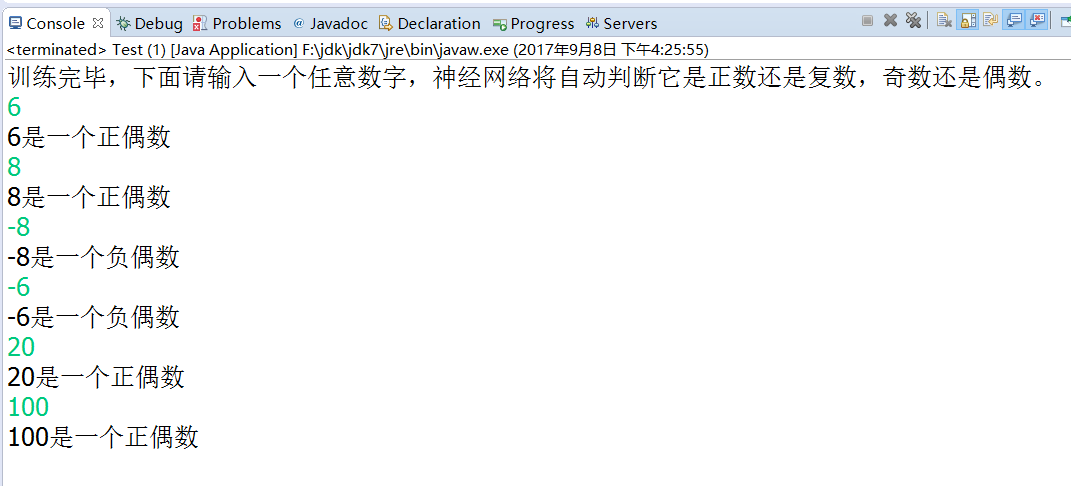機器學習02之BP神經網路圖解及JAVA實現
阿新 • • 發佈:2019-02-07
package com.fei.bp02; public class Bp { private double[] hide1_x;//// 輸入層即第一層隱含層的輸入;hide1_x[資料的特徵數目+1], hide1_x[0]為1 private double[][] hide1_w;// 隱含層權值,hide1_w[本層的節點的數目][資料的特徵數目+1];hide_w[0][0]為偏置量 private double[] hide1_errors;// 隱含層的誤差,hide1_errors[節點個數] private double[] out_x;// 輸出層的輸入值即第二次層隱含層的輸出 out_x[上一層的節點數目+1], out_x[0]為1 private double[][] out_w;// 輸出層的權值 hide1_w[節點的數目][上一層的節點數目+1]// // out_w[0][0]為偏置量 private double[] out_errors;// 輸出層的誤差 hide1_errors[節點個數] private double[] target;// 目標值,target[輸出層的節點個數] private double rate;// 學習速率 public Bp(int input_node, int hide1_node, int out_node, double rate) { super(); // 輸入層即第一層隱含層的輸入 hide1_x = new double[input_node + 1]; // 第一層隱含層 hide1_w = new double[hide1_node][input_node + 1]; hide1_errors = new double[hide1_node]; // 輸出層 out_x = new double[hide1_node + 1]; out_w = new double[out_node][hide1_node + 1]; out_errors = new double[out_node]; target = new double[out_node]; // 學習速率 this.rate = rate; init_weight();// 1.初始化網路的權值 } /** * 初始化權值 */ public void init_weight() { set_weight(hide1_w); set_weight(out_w); } /** * 初始化權值 * * @param w */ private void set_weight(double[][] w) { for (int i = 0, len = w.length; i != len; i++) for (int j = 0, len2 = w[i].length; j != len2; j++) { w[i][j] = 0; } } /** * 獲取原始資料 * * @param Data * 原始資料矩陣 */ private void setHide1_x(double[] Data) { if (Data.length != hide1_x.length - 1) { throw new IllegalArgumentException("資料大小與輸出層節點不匹配"); } System.arraycopy(Data, 0, hide1_x, 1, Data.length); hide1_x[0] = 1.0; } /** * @param target * the target to set */ private void setTarget(double[] target) { this.target = target; } /** * 2.訓練資料集 * * @param TrainData * 訓練資料 * @param target * 目標 */ public void train(double[] TrainData, double[] target) { // 2.1匯入訓練資料集和目標值 setHide1_x(TrainData); setTarget(target); // 2.2:向前傳播得到輸出值; double[] output = new double[out_w.length + 1]; forword(hide1_x, output); // 2.3、方向傳播: backpropagation(output); } /** * 反向傳播過程 * * @param output * 預測結果 */ public void backpropagation(double[] output) { // 2.3.1、獲取輸出層的誤差; get_out_error(output, target, out_errors); // 2.3.2、獲取隱含層的誤差; get_hide_error(out_errors, out_w, out_x, hide1_errors); //// 2.3.3、更新隱含層的權值; update_weight(hide1_errors, hide1_w, hide1_x); // * 2.3.4、更新輸出層的權值; update_weight(out_errors, out_w, out_x); } /** * 預測 * * @param data * 預測資料 * @param output * 輸出值 */ public void predict(double[] data, double[] output) { double[] out_y = new double[out_w.length + 1]; setHide1_x(data); forword(hide1_x, out_y); System.arraycopy(out_y, 1, output, 0, output.length); } public void update_weight(double[] err, double[][] w, double[] x) { double newweight = 0.0; for (int i = 0; i < w.length; i++) { for (int j = 0; j < w[i].length; j++) { newweight = rate * err[i] * x[j]; w[i][j] = w[i][j] + newweight; } } } /** * 獲取輸出層的誤差 * * @param output * 預測輸出值 * @param target * 目標值 * @param out_error * 輸出層的誤差 */ public void get_out_error(double[] output, double[] target, double[] out_error) { for (int i = 0; i < target.length; i++) { out_error[i] = (target[i] - output[i + 1]) * output[i + 1] * (1d - output[i + 1]); } } /** * 獲取隱含層的誤差 * * @param NeLaErr * 下一層的誤差 * @param Nextw * 下一層的權值 * @param output 下一層的輸入 * @param error * 本層誤差陣列 */ public void get_hide_error(double[] NeLaErr, double[][] Nextw, double[] output, double[] error) { for (int k = 0; k < error.length; k++) { double sum = 0; for (int j = 0; j < Nextw.length; j++) { sum += Nextw[j][k + 1] * NeLaErr[j]; } error[k] = sum * output[k + 1] * (1d - output[k + 1]); } } /** * 向前傳播 * * @param x * 輸入值 * @param output * 輸出值 */ public void forword(double[] x, double[] output) { // 2.2.1、獲取隱含層的輸出 get_net_out(x, hide1_w, out_x); // 2.2.2、獲取輸出層的輸出 get_net_out(out_x, out_w, output); } /** * 獲取單個節點的輸出 * * @param x * 輸入矩陣 * @param w * 權值 * @return 輸出值 */ private double get_node_put(double[] x, double[] w) { double z = 0d; for (int i = 0; i < x.length; i++) { z += x[i] * w[i]; } // 2.激勵函式 return 1d / (1d + Math.exp(-z)); } /** * 獲取網路層的輸出 * * @param x * 輸入矩陣 * @param w * 權值矩陣 * @param net_out * 接收網路層的輸出陣列 */ private void get_net_out(double[] x, double[][] w, double[] net_out) { net_out[0] = 1d; for (int i = 0; i < w.length; i++) { net_out[i + 1] = get_node_put(x, w[i]); } } }
(二) BP神經網路的測試
用上面實現的BP神經網路來訓練模型,自動判斷它是正數還是複數,奇數還是偶數.
package com.fei.bp02; import java.io.IOException; import java.util.ArrayList; import java.util.List; import java.util.Random; public class Test { /** * @param args * @throws IOException */ public static void main(String[] args) throws IOException { Bp bp = new Bp(32, 15, 4, 0.05); Random random = new Random(); List<Integer> list = new ArrayList<Integer>(); for (int i = 0; i < 6000; i++) { int value = random.nextInt(1000);//1000內的隨機數 list.add(value); list.add(0-value); } for (int i = 0; i !=25; i++) { for (int value : list) { double[] real = new double[4]; if (value >= 0) if ((value & 1) == 1) real[0] = 1; else real[1] = 1; else if ((value & 1) == 1) real[2] = 1; else real[3] = 1; double[] binary = new double[32]; int index = 31; do { binary[index--] = (value & 1); value >>>= 1; } while (value != 0); bp.train(binary, real); } } System.out.println("訓練完畢,下面請輸入一個任意數字(-1000--1000),神經網路將自動判斷它是正數還是複數,奇數還是偶數。"); while (true) { byte[] input = new byte[10]; System.in.read(input); Integer value = Integer.parseInt(new String(input).trim()); int rawVal = value; double[] binary = new double[32]; int index = 31; do { binary[index--] = (value & 1); value >>>= 1; } while (value != 0); double[] result =new double[4]; bp.predict(binary,result); double max = -Integer.MIN_VALUE; int idx = -1; for (int i = 0; i != result.length; i++) { if (result[i] > max) { max = result[i]; idx = i; } } switch (idx) { case 0: System.out.format("%d是一個正奇數\n", rawVal); break; case 1: System.out.format("%d是一個正偶數\n", rawVal); break; case 2: System.out.format("%d是一個負奇數\n", rawVal); break; case 3: System.out.format("%d是一個負偶數\n", rawVal); break; } } } }




